
THROUGH much of the eighteenth, nineteenth and twentieth centuries, Penny Bridge was a toll bridge on the Bushwick & Newtown Turnpike (end of Meeker Ave). In the seventeenth century, it was the location of a ferry between Laurel Hill / Maspeth and Greenpoint / Bushwick. The ferry was started by Humphrey Clay, an associate of privateer Captain William Kidd.
The bridge was also the main access to Catholic burials in Calvary Cemetery. The Alsop farm was bought by the church in 1837 when land became scarce for burials in Manhattan. There was a need for the turnpike for the transport of Queens produce to and from Williamsburg ferries as well as the funeral processions to Calvary.
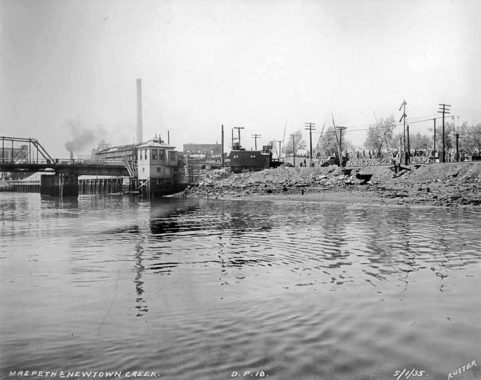
The Penny Bridge that crossed the creek prior to the construction of the first Kosciuszko Bridge was a modest truss bridge that could be moved to allow shipping to pass. It connected the end of Meeker Avenue in Greenpoint with Laurel Hill Boulevard at the south gate of Holy Calvary in Hunters Point. Foot traffic as well as auto traffic was accommodated. In 1939, the immense Kosciuszko replaced it.
For over 100 years this was a stop on the Long Island Rail Road on what is now referred to as the Montauk Branch. The branch ran from Jamaica on tracks through Richmond Hill, Glendale, Fresh Pond, Haberman (an industrial business at 56th Road and 49th Street) and here, at Penny Bridge. The station had ben named for a steel truss bridge that crossed Newtown Creek, connecting Review and Meeker Avenues; according to legend, toll takers collected a penny to cross it at least through part of its history. The bridge was removed after the first Kosciuszko Bridge was built across the creek in 1939.
The station was actually active for a few morning and afternoon runs, using diesel powered locomotives pulling rattling MP-75 cars, until March 1998. This was just before I started carrying a camera with me everywhere for Forgotten New York so unfortunately, I have no visible record of the ride I took on the Montauk that month. By 1998 there were no stationhouses, sheds and very few signs — the stations were just clearings at the tracks, which were unelectrified. The LIRR finally ended service to these stations when new cars with high entrance steps were introduced; otherwise, the MTA would have to spend millions to build high level platforms for stations that saw 2 or 3 riders per day!
Periodically, one City Council member or the other floats ideas to electrify the tracks and turn them into a P or X subway line, but it’s just logrolling. The LIRR used the tracks for a couple of morning runs express from Jamaica to Long Island City until 2010 or so, but now all service to Long Island City, just a couple of trains a day, goes through Hunters Point and the Sunnyside Yards. The line is used completely for freight now.
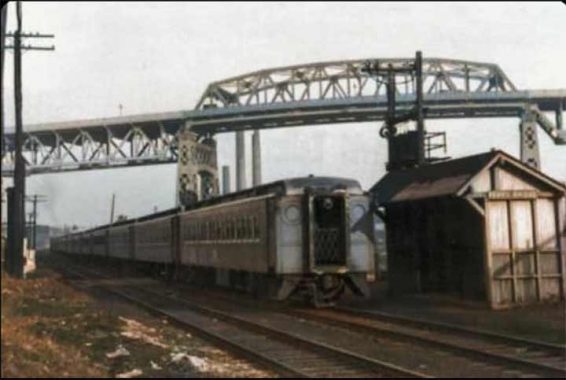
I recently came across several photos of the old Penny Bridge station in the Facebook group Classic NYCTA Subways. Today, it’s difficult to get to this point at the tracks, because the area has been privatized. There were still a few older units running in the late 1960s and early 1970s, and here one can be seen chugging past the Penny Bridge shed.
The station mainly served employees of the industrial plants scattered along Review Avenue, and saw little service even in the 1970s.
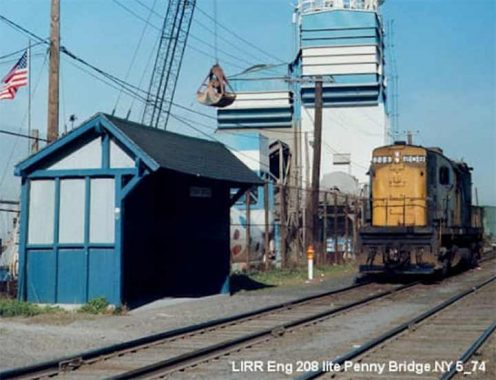
Looking west at the passenger shed in May 1974.
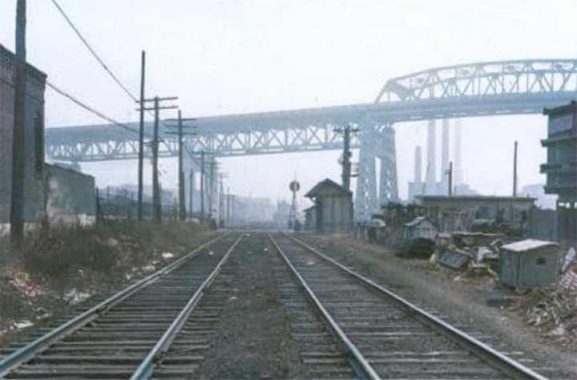
Looking east toward the Old K sometime in the 1970s.

A final look at the new demolished Penny Bridge Station and the Old K, which ended its run in 2017.

In March 1998, when I heard the intermediate stations on the Montauk branch were closing, I got up early, went to Jamaica and caught the 8:13 to LIC, stopping at these stations, which by then were thin patches in the grass alongside the tracks (Richmond Hill was elevated).
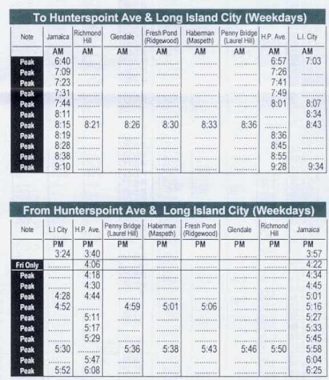
In the afternoons, only two runs used the Montauk tracks, and the first one skipped Glendale and Richmond Hill. Within. a few years, even these runs ended, and today, all LIC service runs through Hunters Point.
Sick transit, Gloria!
As always, “comment…as you see fit.” I earn a small payment when you click on any ad on the site. Take a look at the new JOBS link in the red toolbar at the top of the page on the desktop version, as I also get a small payment when you view a job via that link.
5/10/24


10 comments
I believe that the Penny Bridge abutments are still on the Newtown Creek shoreline.
You used to be able to view the Greenpoint abutment from Laurel Hill Blvd./Review Ave.
Gross! Imagine being huddled inside that cold dark place when its cold and wet outside
waiting for a train
And in the summer it smells like wee wee in there.
I much preferred those sheds to the stuffy fully-enclosed modern waiting rooms (Which are closed half of the time). At least the ones on Long Island, that weren’t urine soaked. You’re taking the train, so you’re dressed for the weather of the day anyway, and the sheds were all you needed to keep the rain/snow/sun off of your head when needed. The railroad was interesting and unpretentious in those days (And worked a lot better). You should have seen the old Republic station at Rte. 110 in Suffolk…..in addition t having 2 of those sheds, the station was built on aHIGH embankment with nearly vertical drop-offs on one side, with flimsy ancient wooden railings being the only thing separating you from “falling off the cliff”. There was even a rail spur that branched off right through the middle of the south platform; and a LONG staircase leading down to Rte 110 on one end, on which if you slipped, you’d probably die.
Pic ofRepublic station: https://arrts-arrchives.com/images2/liREPUBLICr.jpg
My guess for its closure in 1998 was due to low ridership, and the LIRR didn’t want to keep any stations or lines that weren’t making any major revenues hence being a net money losers to them.
In Pittsburgh they took old railroad rights-of-way and made express busways out of them. Probably not practical for the Lower Montauk, though.
Minor Correction/Addition – sentence at the end of the fifth paragraph should read:
“The LIRR finally ended service to these stations when new cars with high platform doors were introduced; otherwise, the MTA would have to spend millions to build high level platforms for stations that saw 2 or 3 riders per day!”
Additional info: The old diesel cars, which built 1955-63, had vestibules with entrance steps for low platform stations. The new diesel cars’ doorways were designed for high-level platforms only, similar to platforms installed at the electrified stations in the late 1960s when the M1 trains were introduced. Otherwise, the new diesel car fleet would have required wheelchair lifts at door openings, a maintenance and operating headache.
Didn’t the LIRR Montauk Branch also have a Maspeth Station at Maspeth Avenue (near the former Clinton/Goodfellas Diner)?
Yes it did. 58th Ave. & Rust street- but it closed c.1903…reopened in the 1920’s again (I think) and then closed again long before the other stations. It was replaced at some point by the Haberman statin at 49th St. and 56th Rd.
Regarding the lead photo… It appears that the ridership was so low on this line and at this stop, that the LIRR just sent an engine out to pick up passenger(s), and omitted the coach… 😉
Penny Bridge Park is one of my favorite quiet little retreats in the midst of industrial East Williamsburg. Looking at a map the nearest part of Queens opposite is the bend of Review Ave I know well from riding past this area by bike (Review being a popular bike way lead to the K bridge) many a time. I’ve often looked across the water from the Park and wondered where in Queens exactly I was looking at. Fascinating how various parts of The City are connected in ways you’d never expect.